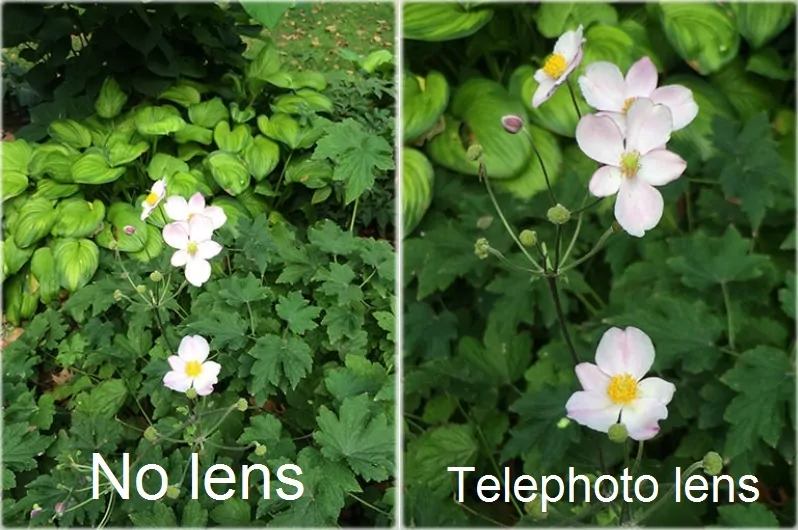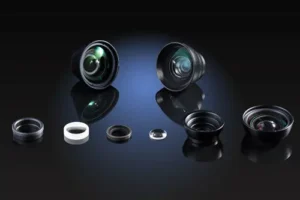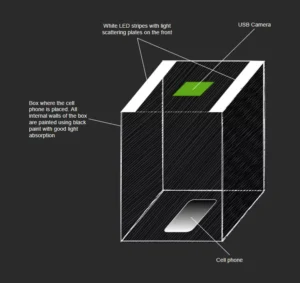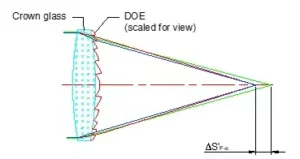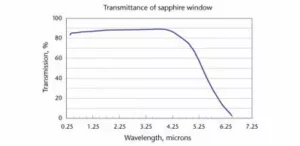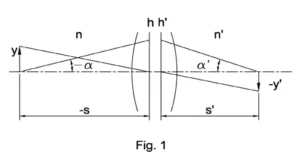As discussed in this post, the design of lens attachments for cell phone cameras presents particular challenges to optical and optomechanical engineers. One common market goal is to decrease the minimum focus distance of a smartphone. In this post, we will discuss key considerations.
Most lens attachments are afocal which means that parallel light rays entering an afocal lens are also parallel when they exit it. However, the diameter of the exiting parallel light rays may be different from that of the incident ones. An afocal lens does not have focal length; its focal point is at infinity. The main purpose of an afocal lens is to modify the system focal lengths and is generally used with other prime lenses.
The operation of a macro lens attachment when the native lens is focused at infinity is presented in the next picture.
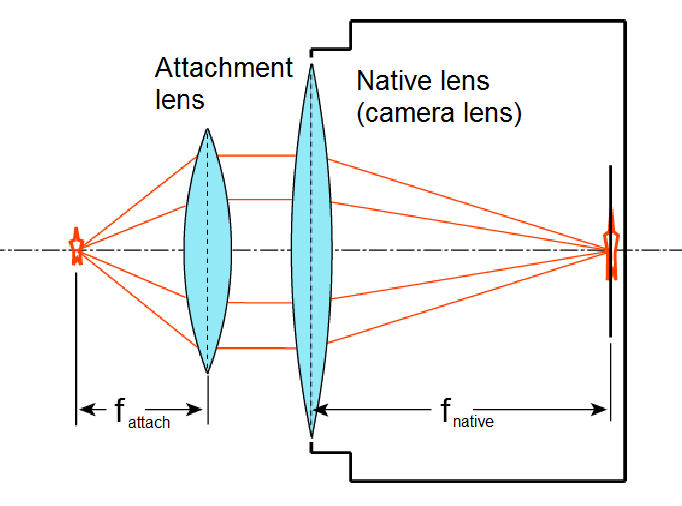
Need assistance designing a custom optic or imaging lens ? Learn more about our design services here.
The magnification expected from a native camera phone lens and lens attachment can be estimated with the simple equations:
1/fcombo=1/fnative+1/fattach
The magnification can be estimated as
m=fnative/fattach
Using smartphone autofocus, we can make small changes in the working distance (+- 3-5 mm)
Since the cameras inside the iPhone, Samsung, HTC, and others have similar properties, a single lens attachment can usually be designed for multiple phones.
Key optical parameters of smartphone cameras:
- Focal length – 3.5-4.5 mm
- F-number – F1.8-2.5
- Minimum focus distance 70-80 mm
- Pupil location is inside the camera lens
- Distortion – less than 2 %
- Resolution – 300-350 lp/mm (usually limited by imaging sensor)
- Number of elements – 4-5 plastic aspherical lenses
Typical design goal:
- Focus 2-5mm (microscopic applications)
- Visual magnification (250/f) -20-25X (microscopic applications)
- Focus 10- 20 mm (macro applications)
- Visual magnification (250/f) – 10-15X (macro applications)
- Maintain resolution, chromatic aberrations, spherical aberrations found in native camera phone.
Design considerations:
- Lens must be afocal. This allows the lens attachment to be used with many types of smartphone cameras. The mounting to the smartphone body should correctly position the lens attachment relative to the camera lens pupil position.
- Lens usually has 2-3 elements and can be as small as possible to simplify the optomechanical design and attachment challenges.
- Different types of glass should be used for chromatic correction and to reduce tooling cost
Design result(macro lens):
In the picture below, you can see what a well-designed macro lens attachment can do. The right side photo is not in focus because the camera focusing range is insufficient. The left photo was taken with a macro lens attachment.
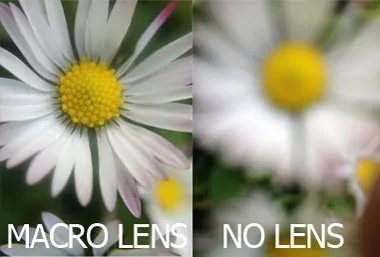
You can find these design principals in products from iPro(Shneider optics), Photojojo, Moment lens, and Olloclip. All offer well designed lenses with high image quality. The lens attachments have comparable optical parameters including magnification, distortion, chromatic, and spherical aberrations.
Lens attachment design, wide angle and telephoto lenses
As mentioned earlier in the description of smartphone attachment lenses, users of iPhone, Galaxy, HTC One, Nexus 5, and other smartphones cannot interchange lenses to alter focal length like they can with an SLR camera
However, it is possible to vary the focal length with afocal attachments fitted in front of the native lens. This is a bit like using a fixed lens camera to take photos through a telescope eyepiece. Afocal attachments of the telescopic type are created by the separation of a pair of lens elements by a distance numerically equal to the sum of their focal lengths.
This modifies the principal planes to infinity, i.e. the device has no focal length. Incident parallel light emerges parallel but the diameter of the beam is changed (see picture).
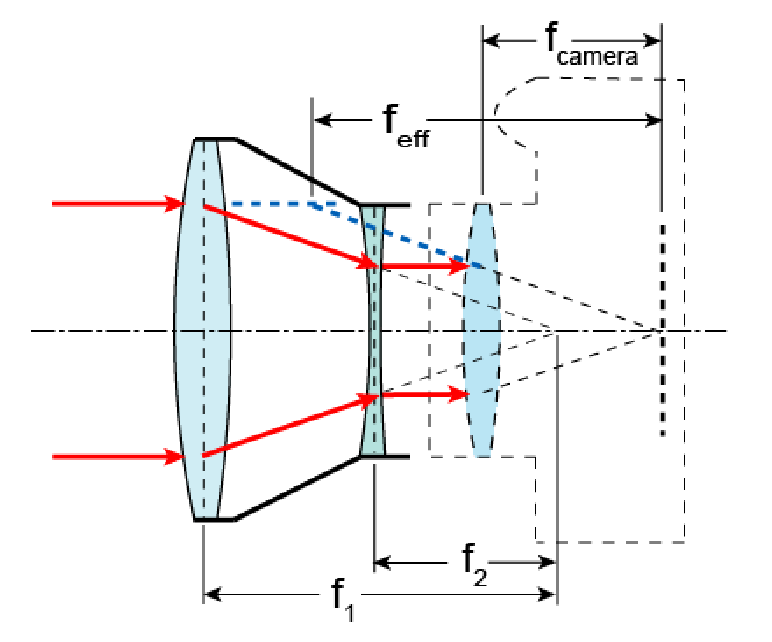
The magnification in this arrangement is given by
m = f1 / f2 = feff / fcamera
when the camera is focused at infinity. For closer distances, the actual magnification from the image size on the sensor depends on the focal length of the camera lens. The main problem of front lens attachments is that these lenses greatly increase the minimum focusing distance.
Using this method, it is possible to create wide angle lens attachments for unique image capture. Typical requirements include:
- Magnification – 0.6-0.7X (0.4-0.5X for super wide angle)
- Resolution (center) – 250-300 lp/mm (close to resolution of native lens)
- Resolution (corner) – 200-250 lp/mm
- Distortion – < 1%
Below you can see how a lens with these parameters changes the captured image.
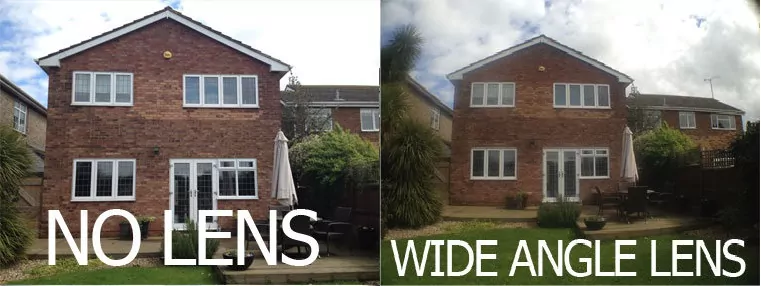
It is also possible to use this design method to create a telephoto attachment. Typical requirements include:
Magnification – 2-2.5X
Resolution (center) – 250-300 lp/mm (close to resolution of native lens)
Resolution (corner) – 100-150 lp/mm
Distortion – < 1%
Design result:
As opposed to a wide angle lens, the telephoto lens attachment decreases the smartphone camera field of view (FOV) presenting a magnified image. This lens also differs from a macro lens attachment because of its long focusing distance and is used in a wide range of working distances.
